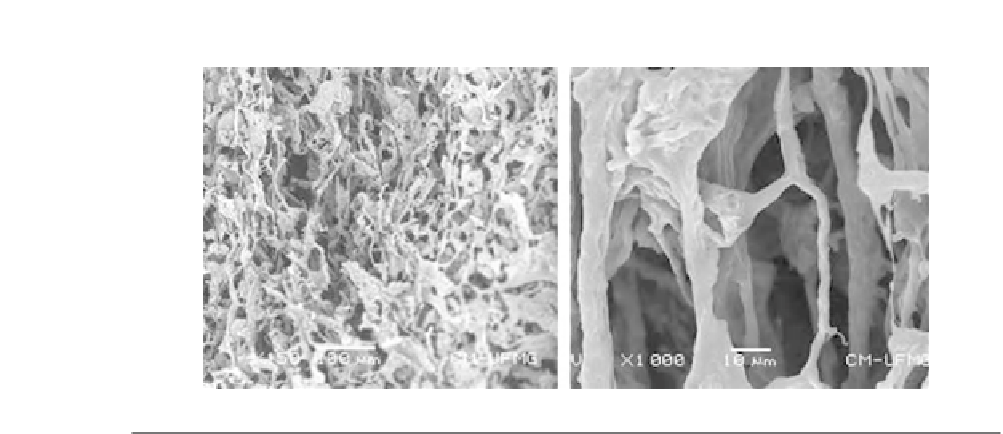Biomedical Engineering Reference
In-Depth Information
(A)
(B)
FIGURE 15.9
SEM image of composite scaffold PU/PVA/bioactive glass nanoparticles: (A) the structure of the
nanocomposite with 2% of bioactive glass nanoparticles and (B) magnification of image.
Oliveira et al. (2011) synthesized and characterized bioactive glass nanoparticles/polyurethane
nanocomposites for tissue engineering applications. The materials presented good cell viability and
HA layer formation upon immersion in simulated body fluid
[16]
(
Figure 15.9
). Currently, there is
great interest in materials with biodegradable polyurethanes for use in medical and dental areas
because of its versatility and biocompatibility. Pereira et al. (2009) developed polyurethane/
montmorillonite nanocomposite to function as membrane for GTR to treat periodontal disease. The
composition, morphology, and mechanical properties of the biomaterials were evaluated. The cellular
viability, proliferation, and morphology changes of rat culture cementoblasts were also investigated.
El-Kady et al. (2010) developed scaffolds of nanocomposite bioactive glass/poly(
L
-lactide) by
sol-gel method. The addition of bioactive glass nanoparticles improved the bioactivity of the mate-
rial in vitro. Marelli et al. (2011) developed composites scaffolds of nanofibrillar collagen with bio-
active glass nanoparticles for use in bone tissue engineering
[87]
. Therefore, those nanocomposites
of bioactive glass have the potential to be applied in tissue engineering.
15.7
Bioactive glass nanocomposite applications in bone regeneration
and dental implants
Several natural and synthetic materials or a combination of them are being developed for tissue engi-
neering in dentistry. Among the natural polymers, chitosan has been widely studied for applications in
dentistry. Chitosan is a biopolymer (polysaccharide) derived from partial deacetylation of chitin. Chitin
is a polysaccharide found abundantly in nature and which constitutes the exoskeletons of insects and
crustaceans. Chitosan is considered as an appropriate functional material for biomedical applications
because of its high biocompatibility, biodegradability, and antibacterial properties. Due to its antibacte-
rial properties
[9]
, chitosan becomes a material suitable for the design of scaffolds for the regeneration
of the alveolar bone since these areas are highly susceptible to bacterial infection
[88,89]
.



